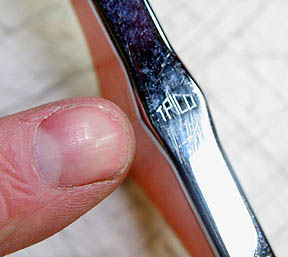All About Ford
Trafficators
Some may call these Semaphores, but others just
call them those goofy signals arms
mounted on the side
By Dean Kirsten
Way before there existed electronic turn signals, and long
before we had blinking body-mounted turn indicators, there were
hand signals. You remember those, what you were suppose to perform
before each turn to let others know you were about to turn in
front of them? Yes, the lost art of sticking your arm out the
window taught to you by your driver,s education teacher so long
ago. But unless you grew up in Europe, particularly England, you
never had the honor of learning all about using Trafficators.
History shows that these handy-dandy little devices date back
to at least the 1930s, but for today, let,s concentrate on the
late forties and early fifties eras.
Ford of England, like all British automotive manufacturers
had to comply with certain guidelines created by the MOT (Ministry
of Transportation), which is similar to our DOT. In the first
step to automate the turn signal process, electronic Trafficators
were installed on most cars and perhaps on some vans. Austin had
them, so they must be cool, right? Ford mounted them on the lower
quarter panel (early 1949 and before), or up higher on the center
"B pillar from 1949 and beyond. I,m sure the lower mounting
position was just too vulnerable to damage, but it may have been
to improve their effectiveness in traffic conditions. Retro kits
were also available to accessory-mount them to any application,
by attaching a supplied metal box to an outside body panel.
Trafficators (Volkswagen called them Semaphores by the way)
were basically electro magnets that when energized with voltage,
would raise an arm up indicating a turn was about to me made.
Once these arms were in the upper position, power would be channeled
to the lens area, via a small wire found inside, and a small tubular
bulb would light up.
Trafficators for Fords were mostly used on 6-volt cars, so
beware. If you plan to use them on your street rod, you will need
to run a separate, constant 6-volt power source that bypasses
the 12-volt flasher relay (you do not want the power to be on
and off for a Trafficator!) You should also know that there are
no reproduction parts for these units. New lenses and bulbs are
nearly impossible to find, so treasure the good used ones you
may have. I have posted three pages of installation instructions
for these units on my web site (www.angliaobsolete.com). These
pages will show how to R&R these units from your Anglia or
Prefect, and came from Trico.
|

Trafficators for Ford applications are unique in their overall
design and shape. Other styles of Trafficators or Semaphores
will not work on the early Anglia and Prefect. This one is from
Tex and is wired for 6-volts.
|

There were three major suppliers: Tex, Trico and Lucas, this
one is of course Tex. Brand name were often stamped into the
frame mount.
|
|

The Trico arms were sometimes chromed, and came in 12-volts
for the Ford V-8 Pilot. Rare.
|

Wiring either uses one wire or two; one wire-style connector
is for hot, with the frame-mount grounded (6V positive ground!).
The two wire-style still only uses one lead as a hot (with the
chassis-mount grounded). The other lead is for the dash indicator
light.
|
|

The shape of the lens is unique for Fords. Notice the raised
rib on the flag-portion.
|

To access the bulb, remove the small screw found on the far
end of the arm. Carefully raise the arm away from the lens. Bulb
contacts metal arm as a ground. A small wire clips on the other
end for the hot lead.
|
|

Small bulbs for a Ford-style Trafficator are mega rare and
usually come in 6-volts.
|

Before you attempt to raise the arm, depress the clutch by
pushing down this lever first!
|
|

When arm is fully raised, this brass rivet comes in contact
with a brass tab to provide power for the bulb. This rivet usually
gets tarnished and needs cleaning.
|

Round field coil is what actually raises the arm up, once
the Trafficator has been switched on.
|

Clutch mechanism should be cleaned of gunk, and lightly greased
before use. |
|